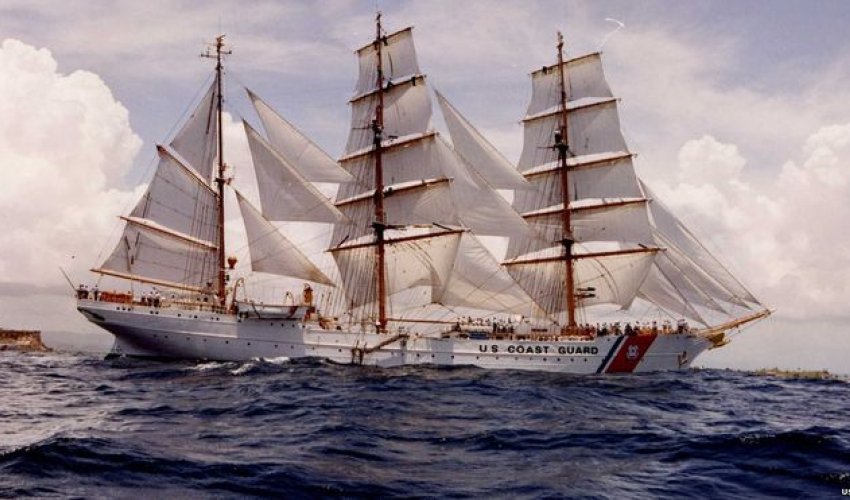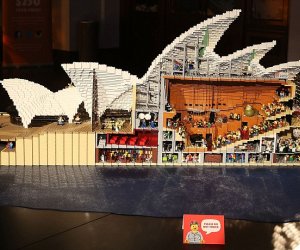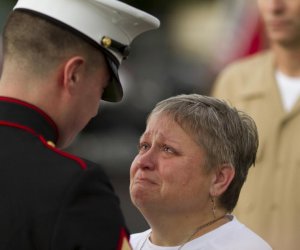Why is the US still using a Nazi tall ship?

The Eagle was built by the Nazis and fought for Hitler in World War Two - so how did a tall ship that once flew the swastika end up as a training vessel for new US Coast Guard cadets?
Driving home along the coast of Connecticut one winter's evening, Tido Holtkamp saw a ghost.
There she was - moored in the harbour, her three towering masts, draped with those familiar sails he had rigged back in the German Navy in World War Two.
Her body had been repainted in the red, white and blue of the US, but her curves were unmistakable.
"That's my ship!" shouted Holtkamp, stopping the car. "That's my ship. The Horst Wessel. What in the world is she doing here in America?"
He may be 89 years old now, but the old sailor still twinkles wide-eyed as he recalls that moment back in 1959.
We are sitting in the grand museum of the Coast Guard Academy in New London, Connecticut, not far from the place where the sight of the ship stopped Holtkamp in his tracks.
Above him hangs a carving of a gleaming golden eagle - the original German figurehead of his beloved vessel.
She is docked outside in the bay, with 150 young cadets preparing to jump aboard, climb the rigging and set sail for the Bahamas.
The Eagle is the flagship of the Coast Guard, and the only tall ship in active service in the US military.
Since 1946 every single new recruit has begun his or her career by learning to sail on her - the old way.
"It may look old-fashioned but the lessons you can learn about the sea and the wind and the currents and yourself - and your fellow shipmates - you cannot learn better on any platform that floats on the lakes or oceans around the world," says Capt Ernst Cummings, one of the ship's former US commanders.
The Eagle has hosted Presidents Kennedy, Nixon and Truman, and circumnavigated the globe as a kind of floating ambassador for US diplomatic relations.
But there is more to her history, a hidden story revealed by the German inscriptions concealed beneath a brass plate on the ship's wheel. And this is the story she shares with Holtkamp.
"Yes, the Eagle is an immigrant too - another immigrant that has done well," he says.
He points to the golden bird hovering above him: "You see that plate she holds in her talons? It's the US Coast Guard shield.
"But not when I sailed on her. The swastika was emblazoned there."
The ship now known as the Eagle was born in the world-famous shipyard of Blohm and Voss in Hamburg, the builders of the battleship Bismarck.
It was 1936, the Nazis were in power and their Kriegsmarine ("war navy") was growing fast.
To train sailors in the ways of the sea a magnificent barque was commissioned - the flagship of the training fleet.
Hitler was present at her launch and Rudolf Hess gave a speech. She was christened "Horst Wessel" after the storm trooper "hero" whose song Horst-Wessel-Lied became an anthem of the Third Reich.
The eagle on her prow was the Nazi Party's eagle, the Parteiadler.
"The Eagle is an emblem of force, strength and bravery - I'm not surprised it was chosen," says Holtkamp.
When World War Two broke out in 1939, the cutter was initially kept in harbour to house a branch of the Hitler Youth.
But in 1942 - with the addition of anti-aircraft guns - she was commissioned for active service in the Baltic Sea.
A year later, in a small town near the German-Dutch border, a tall teenager named Holtkamp was preparing to be called up to the military.
"I was due to be drafted - probably into the army - and that meant the Eastern front," he recalls.
"Well I didn't want to go there, so I volunteered for the navy.
"We were all eagerly hoping to be on a small boat in the Mediterranean, maybe in Greece, with palm trees and beautiful girls. But most of us didn't get that."
Instead, Holtkamp found himself in the Baltic Sea port of Kiel staring at his new home - a training ship.
(BBC)





www.ann.az
Similar news
Similar news
Latest news 
More news 



































 Photo
Photo 



 Video
Video 

